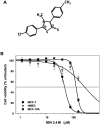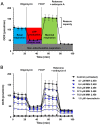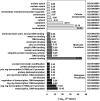Mechanistic studies of cytotoxic activity of the mesoionic compound MIH 2.4Bl in MCF-7 breast cancer cells
- PMID: 32782546
- PMCID: PMC7399858
- DOI: 10.3892/ol.2020.11763
Mechanistic studies of cytotoxic activity of the mesoionic compound MIH 2.4Bl in MCF-7 breast cancer cells
Abstract
In the present study, the cytotoxic effects of a 1,3-thiazolium-5-thiolate derivative of a mesoionic compound, MIH 2.4Bl, were assessed in the MCF-7 breast cancer cell line. The cytotoxic effects of MIH 2.4Bl were determined using a crystal violet assay. Using a dose-response curve, the IC50 value of MIH 2.4Bl was determined to be 45.8±0.8 µM. Additionally, the effects of MIH 2.4Bl on mitochondrial respiration were characterized using oxygen consumption rate analysis. Treating MCF-7 cells with increasing concentrations of MIH 2.4Bl resulted in a significant reduction in all mitochondrial respiratory parameters compared with the control cells, indicative of an overall decrease in mitochondrial membrane potential. The induction of autophagy by MIH 2.4Bl was also examined by measuring changes in the expression of protein markers of autophagy. As shown by western blot analysis, treatment of MCF-7 cells with MIH 2.4Bl resulted in increased protein expression levels of Beclin-1 and ATG5, as well as an increase in the microtubule-associated protein 1A/1B light chain 3B (LC3B)-II to LC3B-I ratio compared with the control cells. Microarray analysis of changes in gene expression following MIH 2.4Bl treatment demonstrated 3,659 genes exhibited a fold-change ≥2. Among these genes, 779 were up-regulated, and 2,880 were down-regulated in cells treated with MIH 2.4Bl compared with the control cells. Based on the identity of the transcripts and fold-change of expression, six genes were selected for verification by reverse transcription-quantitative (RT-q)PCR; activating transcription factor 3, acidic repeat-containing protein, heparin-binding EGF-like growth factor, regulator of G-protein signaling 2, Dickkopf WNT signaling pathway inhibitor 1 and adhesion molecule with Ig like domain 2. The results of RT-qPCR analysis of RNA isolated from control and MIH 2.4Bl treated cells were consistent with the expression changes identified by microarray analysis. Together, these results suggest that MIH 2.4Bl may be a promising candidate for treating breast cancer and warrants further in vitro and in vivo investigation.
Keywords: autophagy; breast cancer; cancer therapy; chemotherapy; cytotoxicity; mesoionic compound; mitochondria.
Copyright: © de Mascena Costa et al.
Figures






References
-
- World Health Organization. WHO report on cancer: Setting priorities, investing wisely and providing care for all World Health Organization, 2020. https://apps.who.int/iris/handle/10665/330745
-
- Santini D, Vincenzi B, Galluzzo S, Battistoni F, Rocci L, Venditti O, Schiavon G, Angeletti S, Uzzalli F, Caraglia M, Dicuonzo G. Repeated intermittent low-dose therapy with zoledronic acid induces an early, sustained, and long-lasting decrease of peripheral vascular endothelial growth factor levels in cancer patients. Clin Cancer Res. 2007;13:4482–4486. doi: 10.1158/1078-0432.CCR-07-0551. - DOI - PubMed
-
- Bhosale SK, Deshpande SR, Wagh RD, Dhake AS. Biological activities of 1, 2, 3-oxadiazolium-5-olate derivatives. Der Chem Sin. 2015;6:79–95.
-
- Badami BV. Mesoionic compounds. Resonance. 2006;11:40–48. doi: 10.1007/BF02835674. - DOI
LinkOut - more resources
Full Text Sources
Research Materials
